JEEP CHEROKEE 2015 KL / 5.G User Guide
Manufacturer: JEEP, Model Year: 2015, Model line: CHEROKEE, Model: JEEP CHEROKEE 2015 KL / 5.GPages: 244, PDF Size: 30.6 MB
Page 201 of 244
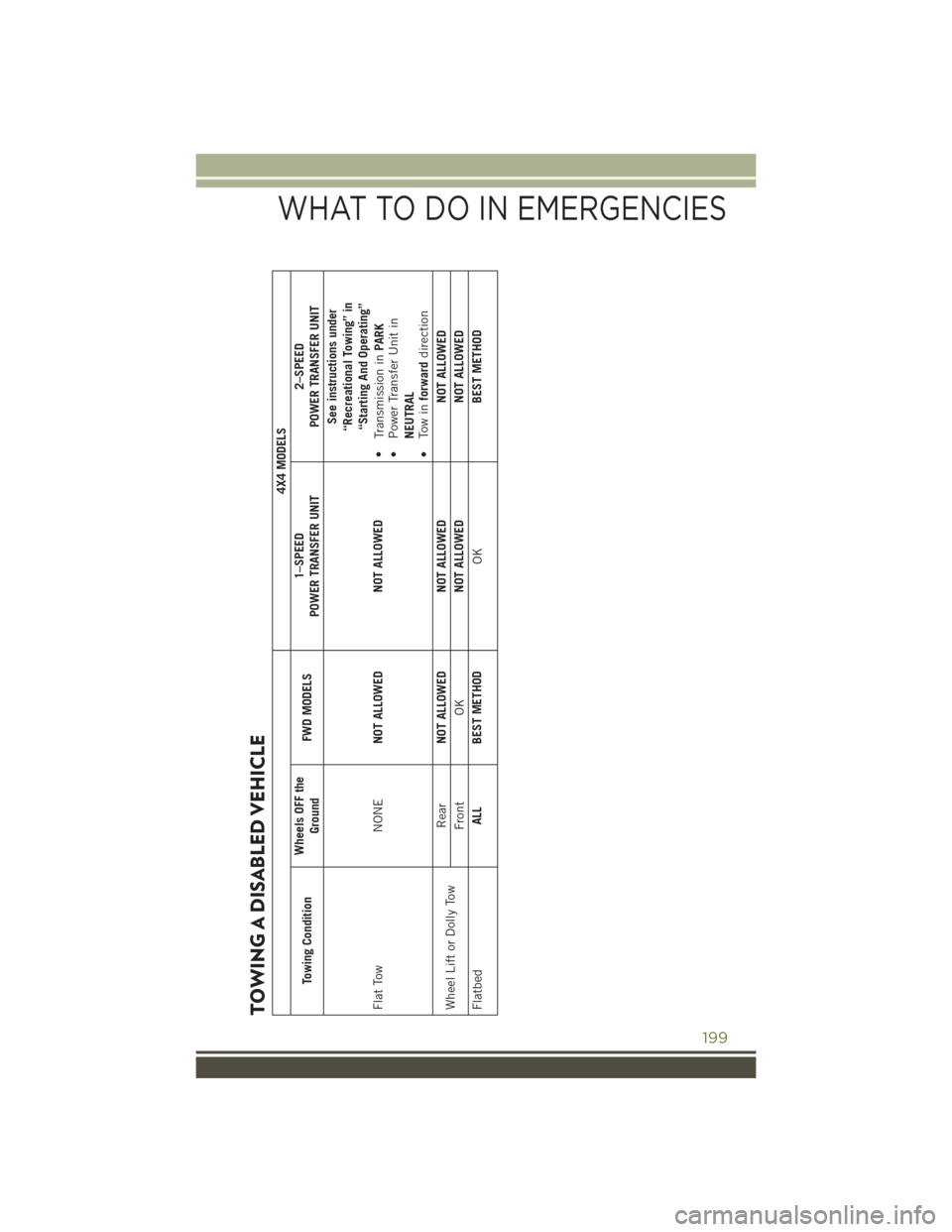
TOWING A DISABLED VEHICLE
4X4 MODELS
Towing Condition
Wheels OFF the
Ground
FWD MODELS
1–SPEED
POWER TRANSFER UNIT
2–SPEED
POWER TRANSFER UNIT
Flat Tow
NONE
NOT ALLOWED
NOT ALLOWED
See instructions under“Recreational Towing” in“Starting And Operating”
•
Transmission in
PARK
• Power Transfer Unit in
NEUTRAL
• Tow in
forward
direction
Wheel Lift or Dolly Tow
Rear
NOT ALLOWED
NOT ALLOWED
NOT ALLOWED
Front
OK
NOT ALLOWED
NOT ALLOWED
Flatbed
ALL
BEST METHOD
OK
BEST METHOD
WHAT TO DO IN EMERGENCIES
199
Page 202 of 244
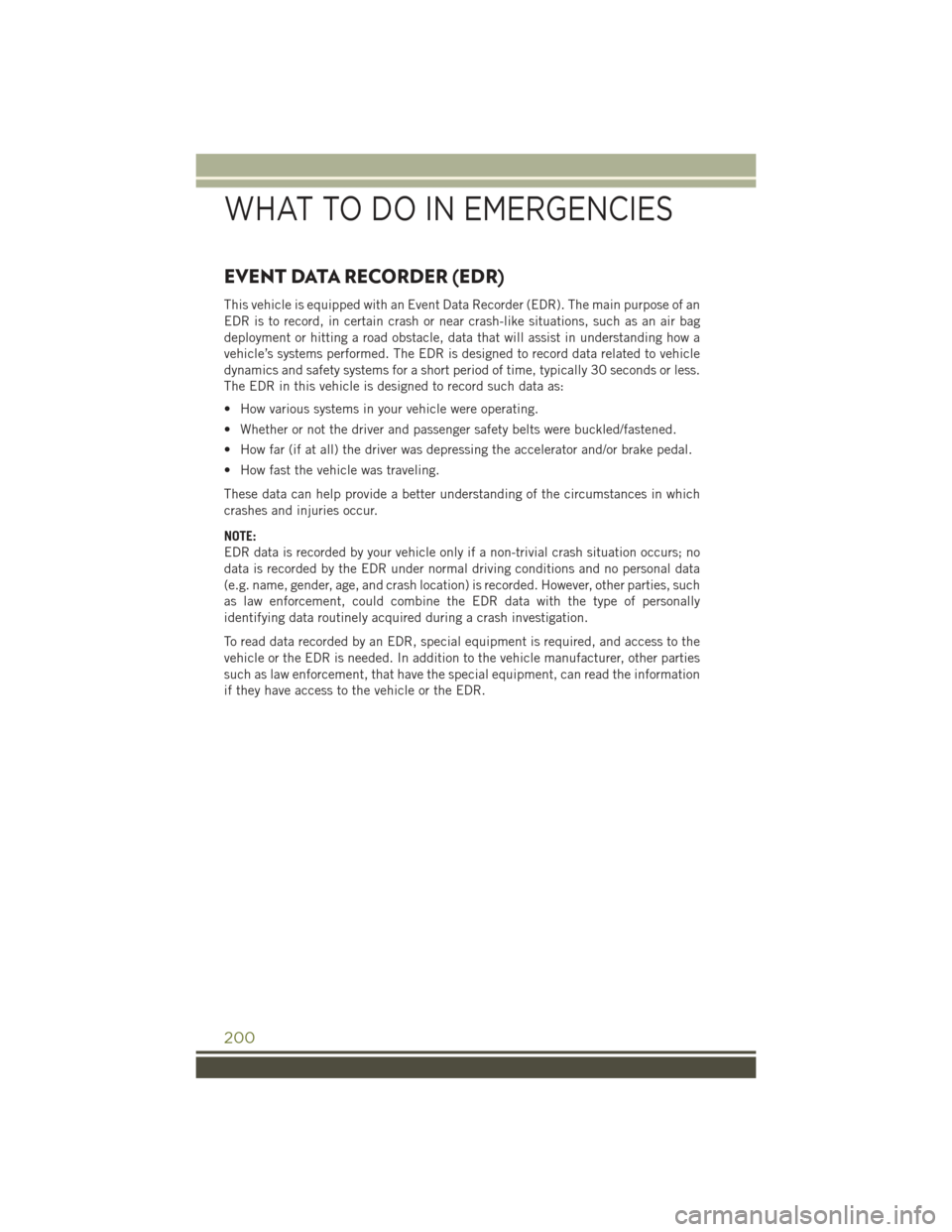
EVENT DATA RECORDER (EDR)
This vehicle is equipped with an Event Data Recorder (EDR). The main purpose of an
EDR is to record, in certain crash or near crash-like situations, such as an air bag
deployment or hitting a road obstacle, data that will assist in understanding how a
vehicle’s systems performed. The EDR is designed to record data related to vehicle
dynamics and safety systems for a short period of time, typically 30 seconds or less.
The EDR in this vehicle is designed to record such data as:
• How various systems in your vehicle were operating.
• Whether or not the driver and passenger safety belts were buckled/fastened.
• How far (if at all) the driver was depressing the accelerator and/or brake pedal.
• How fast the vehicle was traveling.
These data can help provide a better understanding of the circumstances in which
crashes and injuries occur.
NOTE:
EDR data is recorded by your vehicle only if a non-trivial crash situation occurs; no
data is recorded by the EDR under normal driving conditions and no personal data
(e.g. name, gender, age, and crash location) is recorded. However, other parties, such
as law enforcement, could combine the EDR data with the type of personally
identifying data routinely acquired during a crash investigation.
To read data recorded by an EDR, special equipment is required, and access to the
vehicle or the EDR is needed. In addition to the vehicle manufacturer, other parties
such as law enforcement, that have the special equipment, can read the information
if they have access to the vehicle or the EDR.
WHAT TO DO IN EMERGENCIES
200
Page 203 of 244
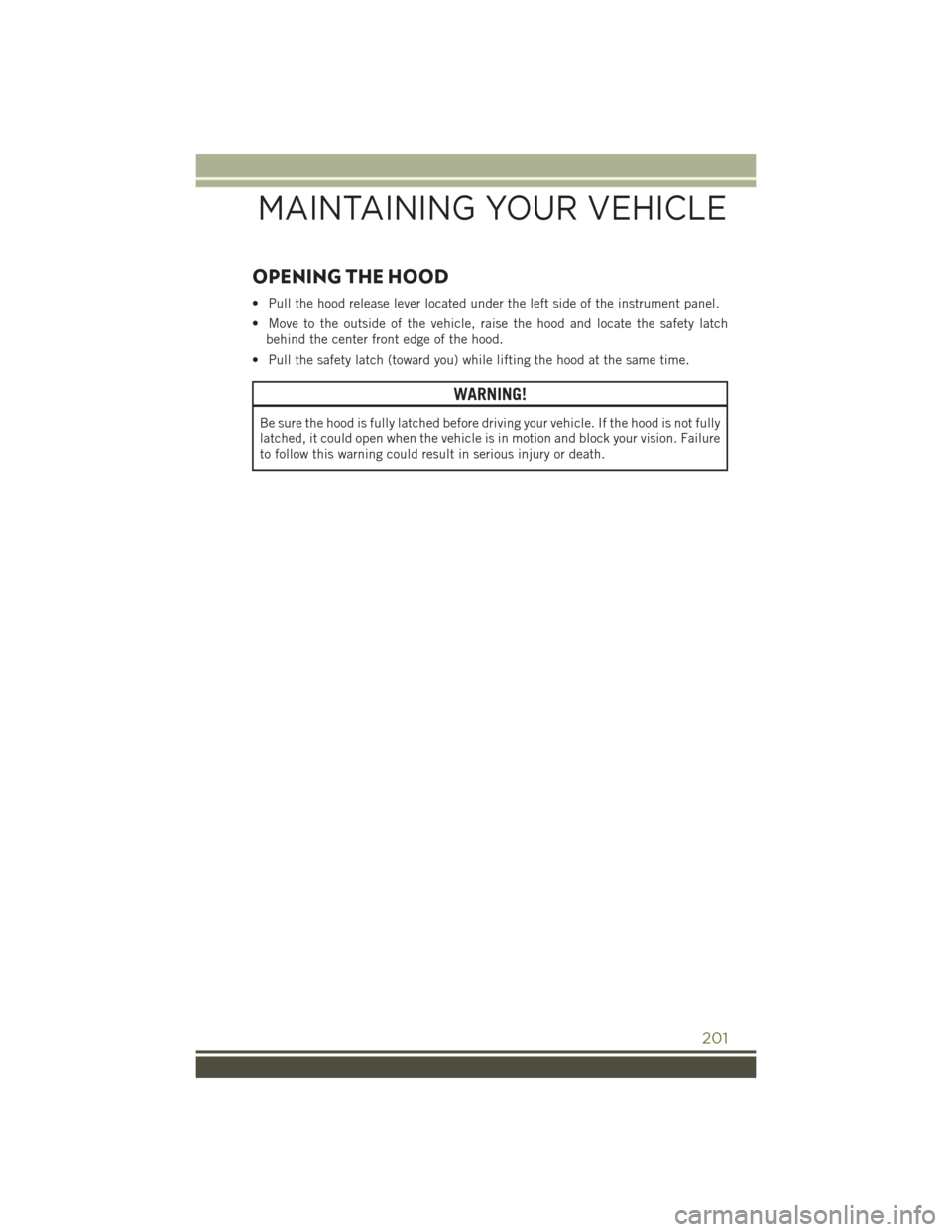
OPENING THE HOOD
• Pull the hood release lever located under the left side of the instrument panel.
• Move to the outside of the vehicle, raise the hood and locate the safety latch
behind the center front edge of the hood.
• Pull the safety latch (toward you) while lifting the hood at the same time.
WARNING!
Be sure the hood is fully latched before driving your vehicle. If the hood is not fully
latched, it could open when the vehicle is in motion and block your vision. Failure
to follow this warning could result in serious injury or death.
MAINTAINING YOUR VEHICLE
201
Page 204 of 244
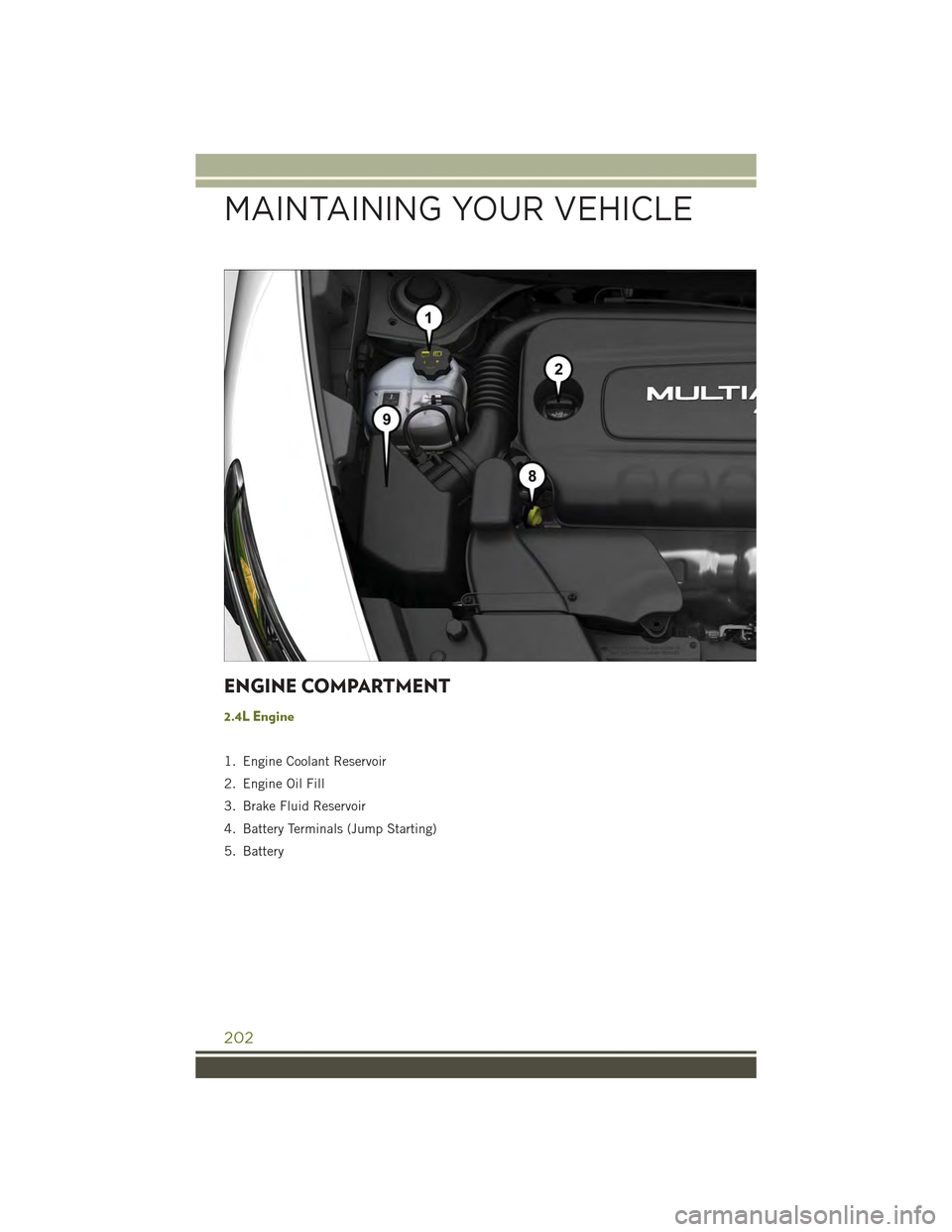
ENGINE COMPARTMENT
2.4L Engine
1. Engine Coolant Reservoir
2. Engine Oil Fill
3. Brake Fluid Reservoir
4. Battery Terminals (Jump Starting)
5. Battery
MAINTAINING YOUR VEHICLE
202
Page 205 of 244
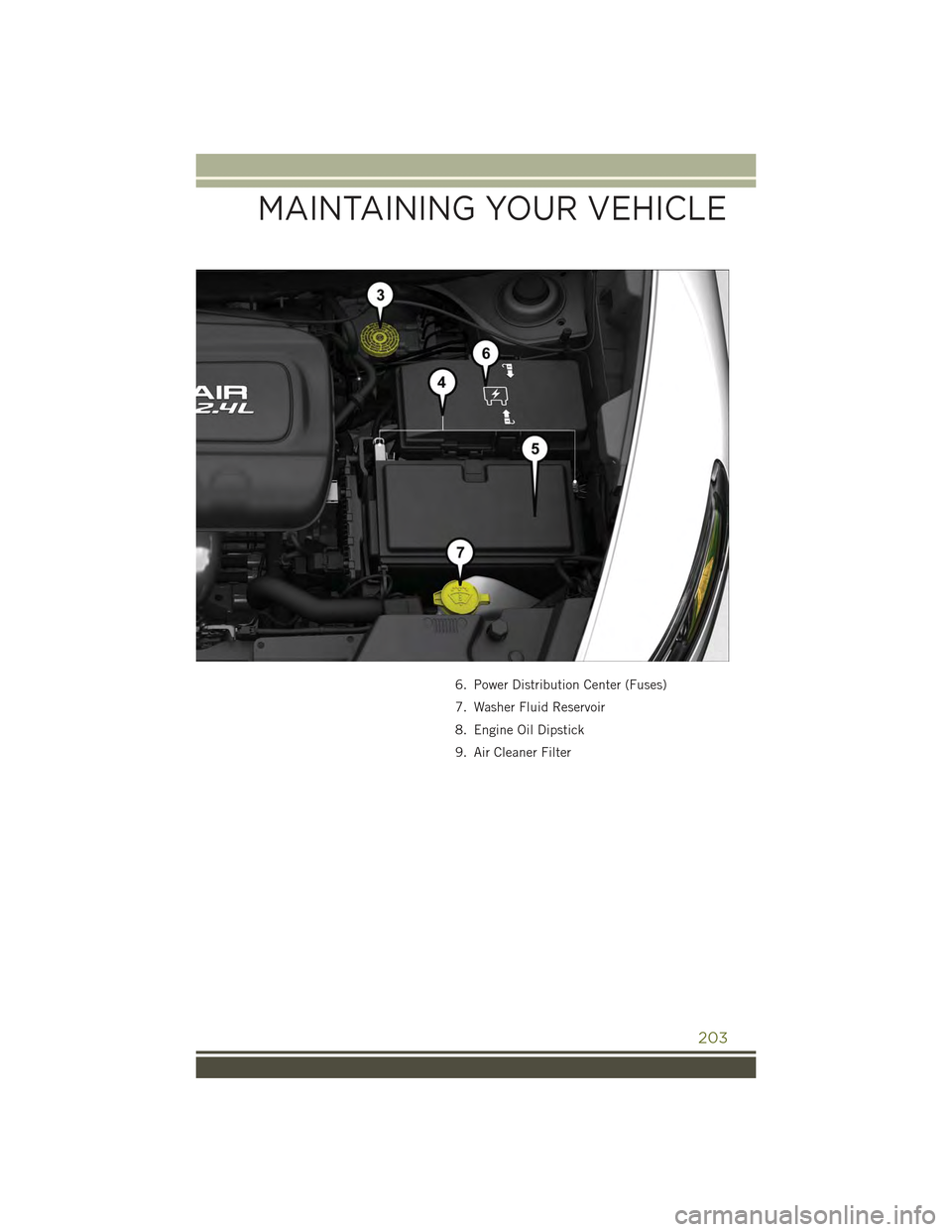
6. Power Distribution Center (Fuses)
7. Washer Fluid Reservoir
8. Engine Oil Dipstick
9. Air Cleaner Filter
MAINTAINING YOUR VEHICLE
203
Page 206 of 244
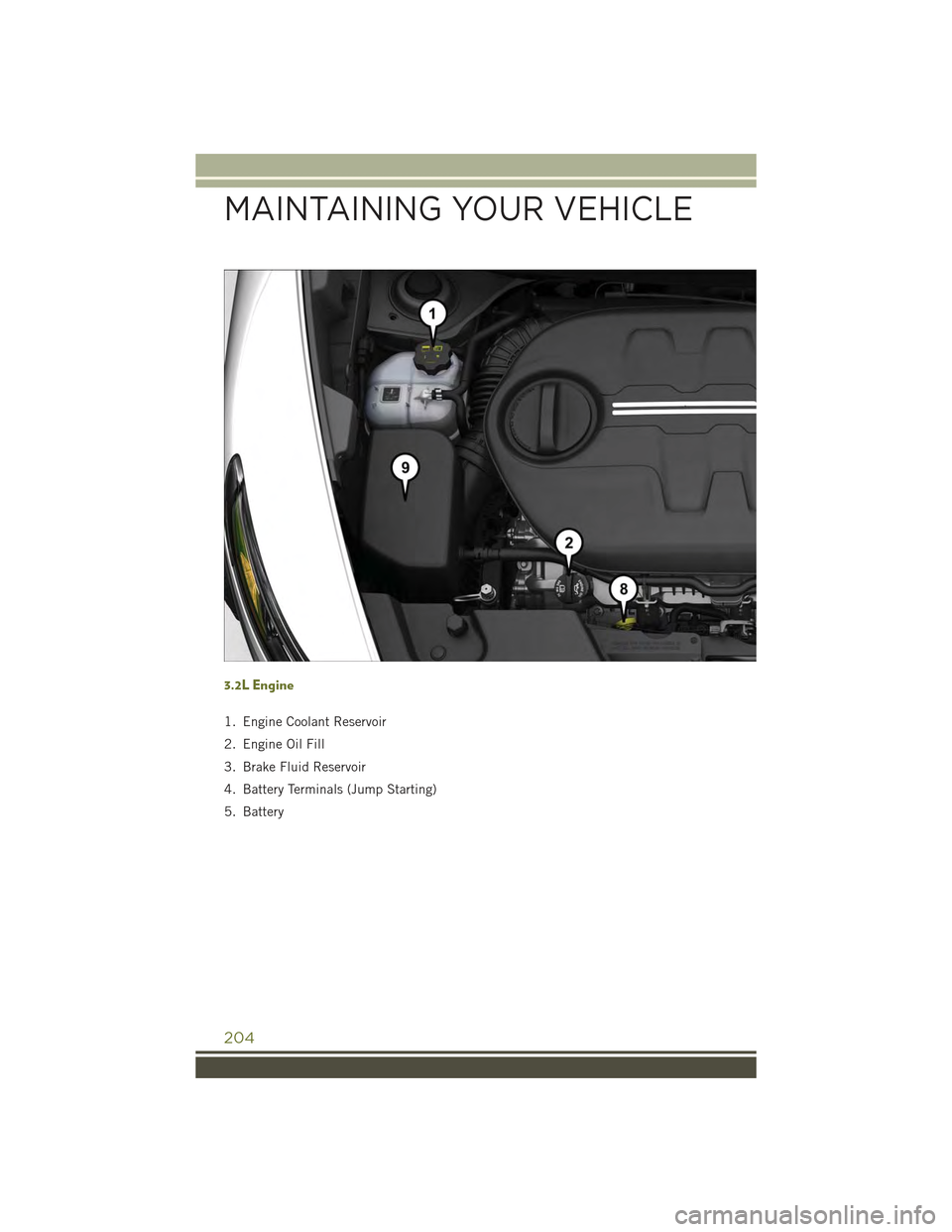
3.2L Engine
1. Engine Coolant Reservoir
2. Engine Oil Fill
3. Brake Fluid Reservoir
4. Battery Terminals (Jump Starting)
5. Battery
MAINTAINING YOUR VEHICLE
204
Page 207 of 244
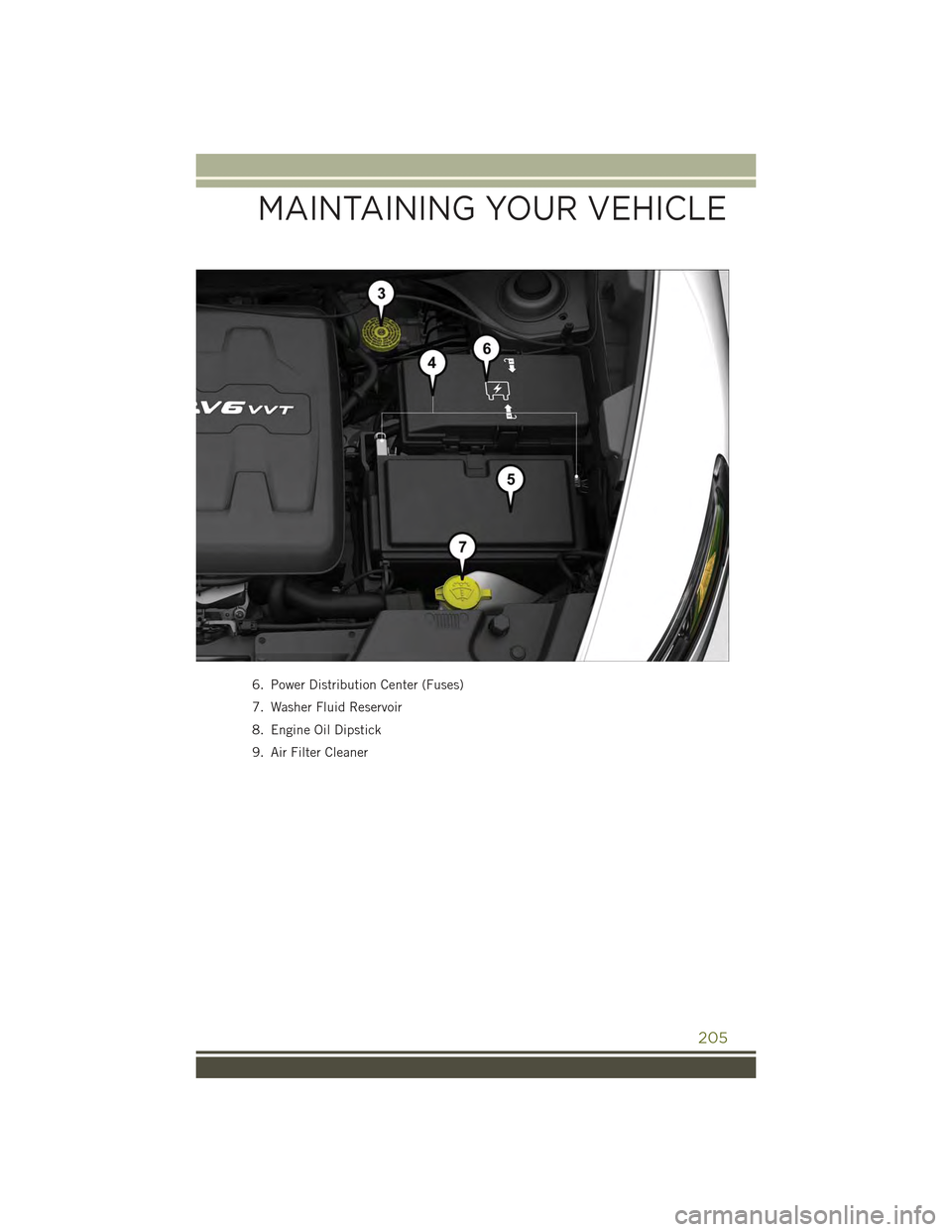
6. Power Distribution Center (Fuses)
7. Washer Fluid Reservoir
8. Engine Oil Dipstick
9. Air Filter Cleaner
MAINTAINING YOUR VEHICLE
205
Page 208 of 244

FLUID CAPACITIES
U.S.Metric
Fuel (Approximate)
2.4L and 3.2L Engines15.8 Gallons60 Liters
Engine Oil With Filter
2.4 Liter Engine(SAE 0W-20, API Certified)5.5 Quarts5.2 Liters
3.2 Liter Engine(SAE 5W-20, API Certified)6 Quarts5.6 Liters
Cooling System*
2.4 Liter Engine (MOPAR®
Antifreeze/Engine Coolant10 Year/150,000 MileFormula)
7.2 Quarts 6.8 Liters
3.2 Liter Engine (MOPAR®
Antifreeze/Engine Coolant10 Year/150,000 MileFormula)
10 Quarts 9.5 Liters
* Includes heater and coolant recovery bottle filled to MAX level.
FLUIDS, LUBRICANTS AND GENUINE PARTS
Engine
ComponentFluid, Lubricant, or Genuine Part
Engine CoolantWe recommend you use MOPAR®Antifreeze/Coolant10 Year/150,000 Mile Formula OAT (Organic AdditiveTechnology) or equivalent meeting the requirements ofChrysler Material Standard MS-12106.
Engine Oil – 2.4L Engine We recommend you use SAE 0W-20 API Certified EngineOil, meeting the requirements of Chrysler Material Stan-dard MS-6395 such as MOPAR®,Pennzoil®,andShellHelix®. Refer to your engine oil filler cap for correct SAEgrade.
Engine Oil – 3.2L Engine We recommend you use API Certified SAE 5W-20 EngineOil, meeting the requirements of Chrysler Material Stan-dard MS-6395 such as MOPAR®,Pennzoil®,andShellHelix®. Refer to your engine oil filler cap for correct SAEgrade.
Engine Oil FilterWe recommend you use a MOPAR®Engine Oil Filter.
Spark Plugs – 2.4L Engine We recommend you use MOPAR®Spark Plugs.
Spark Plugs – 3.2L Engine We recommend you use MOPAR®Spark Plugs.
Fuel Selection – 2.4L/3.2LEngines87 Octane
MAINTAINING YOUR VEHICLE
206
Page 209 of 244
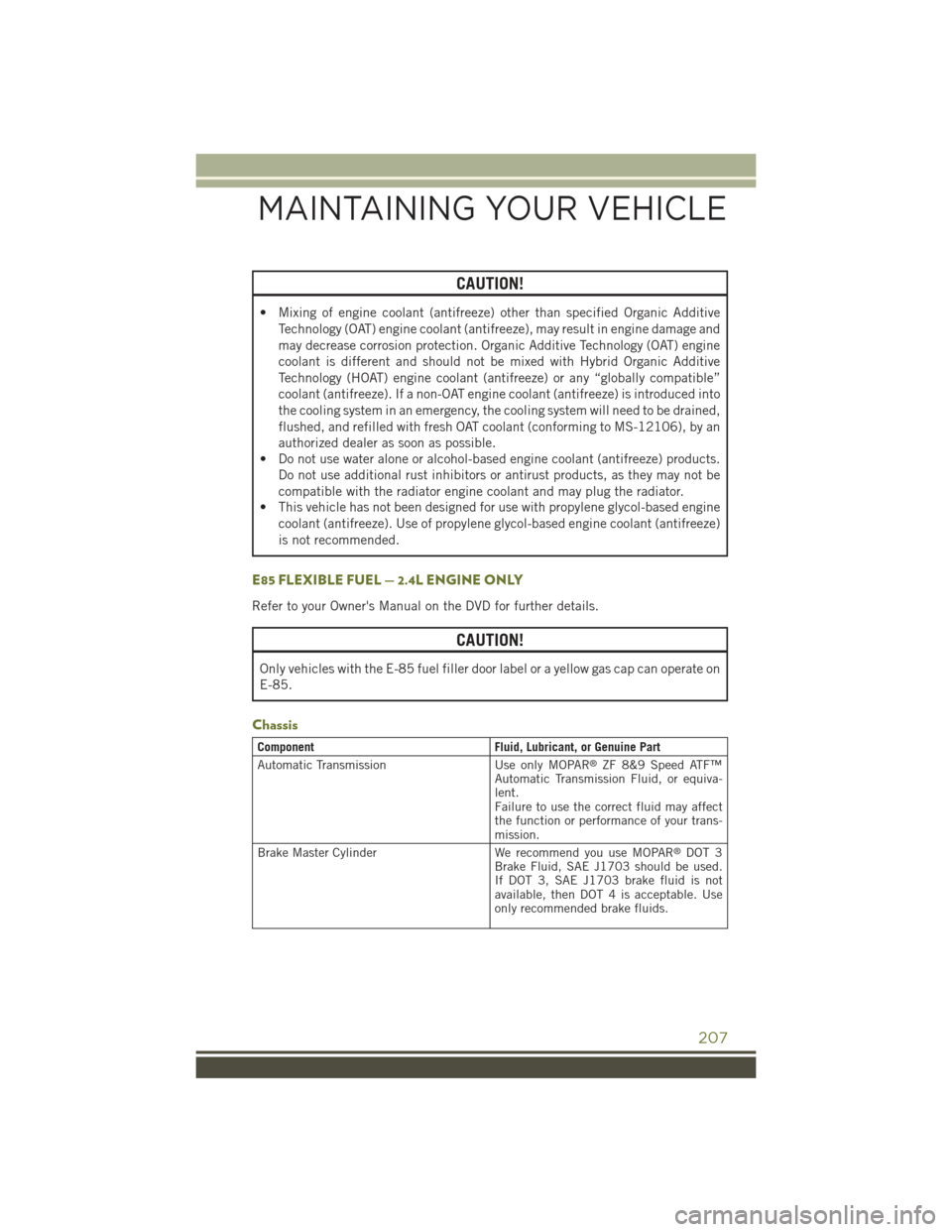
CAUTION!
• Mixing of engine coolant (antifreeze) other than specified Organic Additive
Technology (OAT) engine coolant (antifreeze), may result in engine damage and
may decrease corrosion protection. Organic Additive Technology (OAT) engine
coolant is different and should not be mixed with Hybrid Organic Additive
Technology (HOAT) engine coolant (antifreeze) or any “globally compatible”
coolant (antifreeze). If a non-OAT engine coolant (antifreeze) is introduced into
the cooling system in an emergency, the cooling system will need to be drained,
flushed, and refilled with fresh OAT coolant (conforming to MS-12106), by an
authorized dealer as soon as possible.
• Do not use water alone or alcohol-based engine coolant (antifreeze) products.
Do not use additional rust inhibitors or antirust products, as they may not be
compatible with the radiator engine coolant and may plug the radiator.
• This vehicle has not been designed for use with propylene glycol-based engine
coolant (antifreeze). Use of propylene glycol-based engine coolant (antifreeze)
is not recommended.
E85 FLEXIBLE FUEL — 2.4L ENGINE ONLY
Refer to your Owner's Manual on the DVD for further details.
CAUTION!
Only vehicles with the E-85 fuel filler door label or a yellow gas cap can operate on
E-85.
Chassis
ComponentFluid, Lubricant, or Genuine Part
Automatic TransmissionUse only MOPAR®ZF 8&9 Speed ATF™Automatic Transmission Fluid, or equiva-lent.Failure to use the correct fluid may affectthe function or performance of your trans-mission.
Brake Master CylinderWe recommend you use MOPAR®DOT 3Brake Fluid, SAE J1703 should be used.If DOT 3, SAE J1703 brake fluid is notavailable, then DOT 4 is acceptable. Useonly recommended brake fluids.
MAINTAINING YOUR VEHICLE
207
Page 210 of 244

MAINTENANCE PROCEDURES
For information on the maintenance procedures for your vehicle, please refer to
“Maintenance Procedures” in “Maintaining Your Vehicle” in your Owner’s Manual or
applicable supplement on the DVD for further details.
MAINTENANCE SCHEDULE
Your vehicle is equipped with an automatic oil change indicator system. The oil
change indicator system will remind you that it is time to take your vehicle in for
scheduled maintenance.
Based on engine operation conditions, the oil change indicator message will
illuminate. This means that service is required for your vehicle. Operating conditions
such as frequent short-trips, trailer tow, extremely hot or cold ambient temperatures
will influence when the “Oil Change Required” message is displayed. Severe
Operating Conditions can cause the change oil message to illuminate as early as
3,500 miles (5,600 km) since last reset. Have your vehicle serviced as soon as
possible, within the next 500 miles (805 km).
Your authorized dealer will reset the oil change indicator message after completing
the scheduled oil change. If a scheduled oil change is performed by someone other
than your authorized dealer, the message can be reset by referring to the steps
described under “Instrument Cluster Warning Lights” in “What To Do In Emergen-
cies” in this guide or “Electronic Vehicle Information Center (EVIC)” or “Driver
Information Display (DID)” in “Understanding Your Instrument Panel” in your
Owners Manual on the DVD for further information.
NOTE:
Under no circumstances should oil change intervals exceed 10,000 miles
(16,000 km) or twelve months, whichever comes first.
MAINTAINING YOUR VEHICLE
208